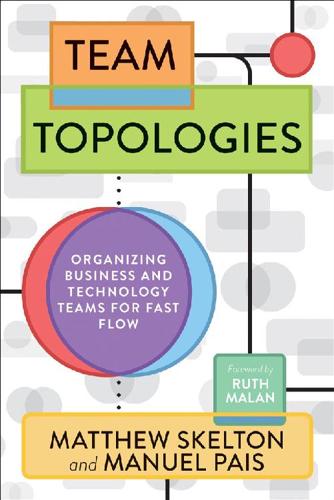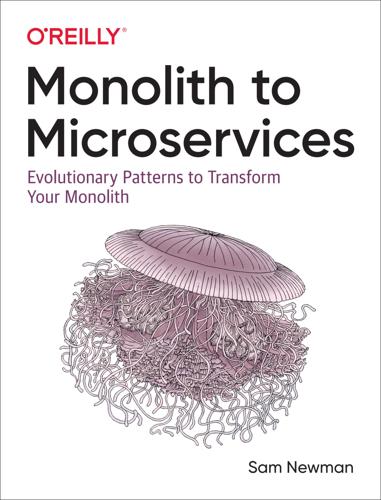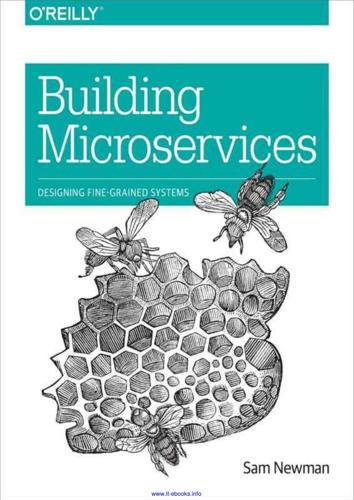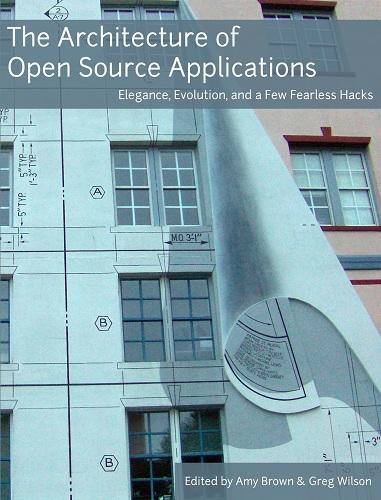Conway's law
description: adage stating that organizations design systems that mirror their own communication structure
8 results

Team Topologies: Organizing Business and Technology Teams for Fast Flow
by
Matthew Skelton
and
Manuel Pais
Published 16 Sep 2019
Dzone.com (blog), March 14, 2013. https://dzone.com/articles/conways-law-v-software. Kelly, Allan. “Conway’s Law & Continuous Delivery.” SlideShare, posted by Allen Kelly, April 9, 2014, https://www.slideshare.net/allankellynet/conways-law-continuous-delivery. Kelly, Allan. “No Projects—Beyond Projects.” InfoQ, December 5, 2014. https://www.infoq.com/articles/kelly-beyond-projects. Kelly, Allan. Project Myopia: Why Projects Damage Software #NoProjects. Allan Kelly: 2018. Kelly, Allan. “Return to Conway’s Law.” Allan Kelly Associates (blog), January 17, 2006. https://www.allankellyassociates.co.uk/archives/1169/return-to-conways-law/. Kersten, Mik.
…
“Exploring the Duality Between Product and Organizational Architectures: A Test of the ‘Mirroring’ Hypothesis.” Research Policy 41, no. 8 (October 2012): 1309–1024. http://www.hbs.edu/faculty/Pages/item.aspx?num=43260. Malan, Ruth. “Conway’s Law.” TraceintheSand.com (blog), February 13, 2008. http://traceinthesand.com/blog/2008/02/13/conways-law/. Manns, Mary Lynn, and Linda Rising, Fearless Change: Patterns for Introducing New Ideas. Boston, MA: Addison Wesley, 2004. Marshall, Bob. “A Team Is Not a Group of People Who Work Together. A Team Is a Group of People Who Each Put the Team before Themselves.” Tweet, @flowchainsensei, October 29, 2018. https://twitter.com/flowchainsensei/status/1056838136574152704.
…
Netflix TechBlog, July 19, 2011. https://medium.com/netflix-techblog/the-netflix-simian-army-16e57fbab116. Newman, Sam. Building Microservices: Design Fine-Grained Systems. Sebastopol, CA: O’Reilly Media, 2015. Newman, Sam. “Demystifying Conway’s Law.” ThoughtWorks (blog) June 30, 2014. https://www.thoughtworks.com/insights/blog/demystifying-conways-law. Nygard, Michael. “The Perils of Semantic Coupling—Wide Awake Developers.” MichaelNygard.com (blog), April 29, 2015. http://michaelnygard.com/blog/2015/04/the-perils-of-semantic-coupling/. Nygard, Michael T. Release It! Design and Deploy Production-Ready Software, 2nd edition. Raleigh, North Carolina: O’Reilly, 2018.

The Stack: On Software and Sovereignty
by
Benjamin H. Bratton
Published 19 Feb 2016
Such flexibility might allow us to differentiate, for example, when the discursive structure of the relational database drives not only the information access policies of a company or state, but also in turn the form of its organizational hierarchies, and when the inverse is predominantly true, such as when the laws and logistics of trade channels structure the form and content of interoperable supply chain management software and the database designs on which it depends. In locating The Stack within the intercourses of economics, culture, and technology, both Conway's law (that organizations design systems in their image) and our inverse Conway's law (that systems and their interfaces produce organizations in their image) are interpretive tools that are useful to keep at hand. As a platform to be read and interpreted, The Stack clearly sits on both sides of this coupling of culture and technology. It relies on software as both a kind of language and a kind of technology, of algorithms of expression and the expression of algorithms, and this twisting of the conceptual and the machinic can sometimes bring emotional distress.19 For some, an apparently universal convertibility of social systems into software systems motivates euphoric convictions in the instantaneous self-realization of networked individuals, a particularly Californian enthusiasm spanning from the ingenious to the idiotic.
…
The Stack, like any other technology of such scale and significance, both constitutes a new political-geographic order and enforces an existing cultural-economic order already in place.16 It does each in different ways and at different locations, and the untangling of these is part of the design brief. Toward this, we have to do more than map platforms; we have to learn to read them and interpret them. Conway's law, coined in 1968 by programmer Melvin Conway, states that “organizations which design systems … are constrained to produce designs which are copies of the communication structures of these organizations.” Put differently, “in order for two separate software modules to interface correctly, the designers and implementers of each module must communicate with each other.
…
See also humans; individuals of cities, 153, 159, 175 identity of, 314 citizenship Cloud-based, 136, 316, 318 of the displaced, 100–101, 159, 310, 409n39 dual, of state and platforms, 115, 319 global, basis of, 257 Google Grossraum, 318 legitimate, 9, 122, 250 mobile, 153, 326 of the modern state, 114 political, 188 sovereign, 122 citizen Users, 115, 159, 299 City and the City, The (Miéville), 112 city-as-airport, 155–157, 162, 405n14 city-as-layer, 151–155 city-as-world, 151 City layer address geographies, 193–195 apparatuses, 163–168 appetites of, 154 basic building unit, 148 boundary reversibility, 148–149 City versus City warfare, 154 to come, 314, 320–327 composition, 152, 179 computational hyperobjects embedded, 227–228 control structures, 174 defined, 369 design, 167–172 economics, 159–160 envelopes, 12, 70, 148–149, 152, 154–155, 163–171, 173 exposure and control, 155–160 force finding function finding form, 160–163 function of, 149 generative accidents, 175 geodesign, 321 geopolitics, 444n26 grids, 149–153 ideal cities distinction, 150 infrastructures, 151–153 interfacial problematics of, 167, 256 introduction, 70, 147–151 jurisdiction, 357 megastructural form, 176–183 sovereign accidents, 172–176 Stack integration, 154–155, 170 territories of, 154 Users, 148–149, 154, 163–164 violence below, 155 City layer interactions Address layer, 153, 211 Cloud layer, 110, 153 Earth layer, 153 Interface layer, 124 city-states, 4, 144, 163 City-states, 299, 352 climate, state and, 395n73, 398n21 climate and weather systems, 88 climate change crisis of ongoingness, 295, 306 denial, 457n10 finding solutions for, 88–90, 259, 443n13 refugees of, 100–101 sovereign duty to suppress, 98 clinamen, 77, 358–359 Clinton, Hillary, 3, 13, 319, 351 Cloud layer access to, limiting, 314 beginnings, 110 Cloud-based state, 109, 119–121, 295, 316, 327, 399n36, 441n8 Cloud-based User-response-driven systems, 255 Cloud corporations, 183 to come, 295–296, 299, 307–319 decentralization, 156–157 defined, 67, 369 design, 141–145 economics, 116, 136–138 feudalism, 111, 143, 295, 307–309, 317–318, 328, 369 geography, 123 geopolitics, 26, 110–112, 114, 118–119, 124, 141–145, 454n75 governance of, 68, 140, 143 as grid, 140 growth, limits to, 94, 117–118 importance of, 125 infrastructure, 67, 115–119, 124 interfacial problematics, 256 introduction, 70, 109–111 jurisdiction, 113–114, 140 landfill, 94 metadata, 116 as physical, 29 productive accidents of, 112, 114, 145 services, 116–118 terraforming project of, 111, 115–116 tethers, 82, 148 (see also mobile devices) Cloud layer interactions Address layer, 152, 211 City layer, 110, 153 Earth layer, 94, 110, 140–141 User layer, 124, 154, 168, 187 Cloud Polis Amazon model, 131–133, 331, 369 Apple model, 128–131, 187–188 availability of, 312 China-Google conflict, 9, 112–115, 143–144, 245, 361 China model, 143 to come, 122–123, 298, 313, 316–319 defined, 369–370 design of, 109, 124, 141–145 exclusionary, 309, 311–312, 317 Facebook model, 125–128, 187–188 Google model, 134–141, 143, 184–185, 187–188, 332, 369 interfacial regime, 339–340 introduction, 109–110 megastructure headquarters, 155 model of planetary urbanity, 258 political economic architecture, 124 popular discourse on, 312–313 present-day, 119–122, 318 revenue stream, 295 reversibility of, 319 of things, 131 Walmart model, 331 Clouds (Aristophanes), 109 Clow, Lee, 128 cocaine, 173 cockroaches, 275, 285 cognition, militarization of, 297 cognition-interfaciality synthesis, 297 cognitive capitalism, 110, 116, 203, 241, 258, 295 Cohen, Jared, 134–136, 361 coin mining, 393n54 Cold War, 325 coltan (tantalum), 82–83 columns accessing, 68, 298, 314 defined, 67, 370 function of, 66–67 intention linked through interface, 286 Interfaces, activating, 67–68, 220 layers within, totalities between, 68–69 policing, 287 Stack-to-come, 301 User initiation, 67 User interests, interpolating, 253, 313–314 User-to-User connections, 67, 286, 301, 370 Comcast, 119 “Coming Civil War over General-Purpose Computing, The” (Doctorow), 285 command and communication technologies, 242 Commissioners’ Grid Plan, 42 communication absolute, logic of, 214 addresses as networks for, 132, 153–154, 192–195 Address layer, 210–212 architecture for, 148, 161 in cars, 280 defined, 210 geographies of, 210 human, structuring, 128 human-to-human, 198, 340 human-to-nonhuman, 136–137, 171–172, 198, 340 images for, 127 mediascape in, 148 object-to-object, 197–198, 210, 212, 216, 338 physical/virtual, 196 real-time, 168 restrictions on, 194, 196 standards, 54 traceability between lines of, 205 universal, addressing tables enabling, 192 communication networks, 55, 132 communities of Users, 288–289 comparative planetology, 300–302, 333, 353, 360 composite User, 281, 362 computability, 55 computation, 55, 75–80, 388n5 Computer City, 179 “computer everywhere” infrastructure, 13–14, 59–60, 301–302, 356 computer science, 327 conflict minerals, 82–83 conspiracy theory politics, 128, 459n19 Constant (Constant Nieuwenhuys), 178 consumer electronics, 82–83, 179. See also mobile devices Continuous Monument (Superstudio), 178 control, defined, 157, 222 control city, Deleuze, 157–158 Conway, Melvin, 56 Conway's law, 56–57 Copernican rotations of human autophenomenology, 287 “Cosmism” (Federov), 328 cosmograms, 91, 235, 243, 246 cosmopolitanism accidental, 70 to come, 17 cosmopolitan logic, 318, 322 cosmopolitics, 247, 306 informational, 135, 315 Kantian, 6, 153, 354 material, 257 postsecular, 318 proto-, 256–257 User, 175, 286 Costa Rica-Nicaragua border conflict, 9, 120, 144 counterespionage, crowd-sourcing, 110, 398n21 counterterrorism discourse, 324, 355 Cremaster 3 (Barney), 183 crime embodied, 156, 175–176 crisis of addressability, 26, 199, 335 “Critique of Violence, A” (Benjamin), 20 Crying of Lot 49, The (Pynchon), 194 crypto City-states, 352 cryptographic tools, 405n16 Cryptonomicon (Stephenson), 400n42 Crystal Island, Moscow (Foster), 182, 188 culpability, User, 346 cultural-economic order, 56 currency.

The Mythical Man-Month
by
Brooks, Jr. Frederick P.
Published 1 Jan 1975
What: product specifications. This begins as a proposal and ends up as the manual and internal documentation. Speed and space specifications are a critical part. When: schedule How much: budget Where: space allocation Who: organization chart. This becomes intertwined with the interface specification, as Conway's Law predicts: "Organizations which design systems are constrained to produce systems which are copies of the communication structures of these organizations."1 Conway goes on to point out that the organization chart will initially reflect the first system design, which is almost surely not the right one.

Monolith to Microservices: Evolutionary Patterns to Transform Your Monolith
by
Sam Newman
Published 14 Nov 2019
component-driven UIs, And mobile applications consistency (ACID transactions), ACID Transactions Constantine's law, On Coupling and Cohesion consumer-driven contracts (CDCs), Use consumer-driven contracts content-based router, using to intercept messaging calls, Content-based routing continuous delivery (CD), Deployment coupling Continuous Delivery (Humble and Farley), Deployment coupling contracts, Breaking Changesconsumer-driven, Use consumer-driven contracts one microservice exposing two contracts, Give consumers time to migrate Conway's law, Modeled Around a Business Domain copying code from the monolith, Cut, Copy, or Reimplement? core competency, teams structured around, Shifting Structures correlation IDs (CIDs), Choreographed sagas, Tracing costsavoiding the sunk cost fallacy, Avoiding the Sunk Cost Fallacy cost-effective scaling for load, Scale Cost-Effectively for Load of change, Cost of Change-Easier Places to Experimenteasier places to experiment, Easier Places to Experiment reversible and irreversible decisions, Reversible and Irreversible Decisions couplingabout, Coupling and cohesion, balancing, On Coupling and Cohesion deployment, Deployment coupling domain, Domain coupling implementation, Implementation coupling temporal, Temporal coupling credentials, separate, for database access, The Database as a Public Contract credit derivative pricing, comparing using parallel run, Example: Comparing Credit Derivative Pricing culture (organizational)anchoring new approaches in the culture, Anchoring New Approaches in the Culture and adaptability to change or process improvements, Being Open to New Approaches customer-installed software, Customer-Installed and Managed Software D dark launching, parallel run pattern and, Dark Launching and Canary Releasing data consistency, As a Fallback Mechanismeventual consistency, Data Synchronization, Synchronizing the data in ACID transactions, ACID Transactions in move foreign key relationship to code pattern, Data Consistencycheck before deletion, Check before deletion deciding how to handle deletion, So how should we handle deletion?

Building Microservices
by
Sam Newman
Published 25 Dec 2014
service-to-host mapping, Service-to-Host Mapping-Platform as a Serviceapplication containers, Application Containers multiple services per host, Multiple Services Per Host platform as a service (PaaS), Platform as a Service single service per host, Single Service Per Host terminology, Service-to-Host Mapping service-to-service authentication/authorization, Service-to-Service Authentication and Authorization-The Deputy ProblemAPI keys, API Keys client certificates, Client Certificates confused deputy problem, The Deputy Problem HMAC over HTTP, HMAC Over HTTP HTTP(S) basic, HTTP(S) Basic Authentication man-in-the-middle attacks, Allow Everything Inside the Perimeter SAML/OpenID Connect, Use SAML or OpenID Connect sharding, Scaling for Writes shared code, DRY and the Perils of Code Reuse in a Microservice World shared data, Example: Shared Data shared libraries, Shared Libraries shared models, Shared and Hidden Models shared static data, Example: Shared Static Data shared tables, Example: Shared Tables sharing behavior, The Shared Database single sign-on (SSO), Common Single Sign-On Implementations-Single Sign-On Gateway smoke test suites, Separating Deployment from Release spies, Mocking or Stubbing SSH-multiplexing, Single Service, Multiple Servers SSL certificates, HTTP(S) Basic Authentication SSL termination, Load Balancing standards enforcementexemplars, Exemplars tailored service templates, Tailored Service Template standards establishment, The Required Standard-Architectural Safetyarchitectural safety, Architectural Safety importance of, The Required Standard interfaces, Interfaces monitoring, Monitoring static data, Example: Shared Static Data Strangler Application Pattern, The Strangler Pattern, Architectural Safety Measures strategic goalsreal-world example, A Real-World Example understanding, Strategic Goals stubbing vs. mocking, Mocking or Stubbing Suro, The Future Swagger, Swagger synchronous communication, Synchronous Versus Asynchronous synthetic monitoring, Synthetic Monitoring system designaccountability and, People adapting to communication pathways, Adapting to Communication Pathways bounded contexts, Bounded Contexts and Team Structures case study, Case Study: RealEstate.com.au Conway's law of, Conway’s Law and System Design delivery bottlenecks, Delivery Bottlenecks effect on organizational structure, Conway’s Law in Reverse feature teams, Feature Teams internal open source model, Internal Open Source organizational structure and, Evidence orphaned services, The Orphaned Service?

The Nature of Software Development: Keep It Simple, Make It Valuable, Build It Piece by Piece
by
Ron Jeffries
Published 14 Aug 2015
When the back end is being developed along with the front end, you might think the result would be a cleaner, better, tighter integration. It’s possible that could happen, but it doesn’t come automatically; it depends on Conway’s law. The more common result is that both sides of the integration end up aiming at a moving target. Conway's Law In a Datamation article in 1968, Melvin Conway described a sociological phenomenon: “Organizations which design systems are constrained to produce designs whose structure are copies of the communication structures of these organizations.” It is sometimes stated colloquially as, “If you have four teams working on a compiler, you will get a four-pass compiler.”

The Architecture of Open Source Applications
by
Amy Brown
and
Greg Wilson
Published 24 May 2011
Footnotes In most cases, a sequence of one of the characters. The exec builtin is an exception to this rule. The Architecture of Open Source Applications Amy Brown and Greg Wilson (eds.) ISBN 978-1-257-63801-7 License / Buy / Contribute Chapter 4. Berkeley DB Margo Seltzer and Keith Bostic Conway's Law states that a design reflects the structure of the organization that produced it. Stretching that a bit, we might anticipate that a software artifact designed and initially produced by two people might somehow reflect, not merely the structure of the organization, but the internal biases and philosophies each brings to the table.

Seeking SRE: Conversations About Running Production Systems at Scale
by
David N. Blank-Edelman
Published 16 Sep 2018
., Context Versus Control in SRE-Context Versus Control in SRE continuous delivery/deploymentchampioning, Championing CD database reliability engineering and, Continuous Delivery: From Development to Production-Tools deployment, Deployment-Championing CD immutable infrastructure and, Continuous Integration/Continuous Deployment with Confidence third-party integrations and, Testing and staging continuous integrationimmutable infrastructure and, Continuous Integration/Continuous Deployment with Confidence third-party integrations and, Testing and staging contract termination, Decommissioning control plane, Configuration Management (Control Plane Versus Data Plane) convolutional neural networks, How and When Should We Apply Neural Networks? Conway's law, Getting Buy-In, The Computer and Human Systems Cannot Be Separated Conway, Mel, The Computer and Human Systems Cannot Be Separated Cook, Richard, SRE Cognitive Work, Introduction-Conclusion coordination overheadin complex systems, Nobody Anticipates the Overhead of Coordination managing, Managing the Costs of Coordination costs of incidents, Incidents Will Impose Costs-Incidents Will Impose Costs Cowling, James, Engineering for Data Durability, Engineering for Data Durability-Conclusion crisesand persons with mental disorders, Leaving as scarcity of time/attention, The corollary to trust is forgiveness crisis management, Managing Crisis: Responding When Things Break Down-The corollary to trust is forgiveness cross-domain failures, Introducing Production Engineering-Introducing Production Engineering cross-functional teams, Get Rid of as Many Handoffs as Possible-Get Rid of as Many Handoffs as Possible cross-team reliability, Resolving Cross-Team Reliability Issues by Using Postmortems cultural fit interviews, Cultural interviews culture (see success culture, SRE as) D dashboards, Real-Time Dashboards: The Bread and Butter of SRE data durability, engineering for, Engineering for Data Durability-Conclusionautomation, Automation-Reliability backups, Backups estimating durability, Estimating durability-Estimating durability freshness, Freshness isolation, Isolation-Operational isolation protection, Protection-Recovery real-world strategies, Real-World Durability-Reliability recovery, Recovery replication, Replication Is Table Stakes-Estimating durability replication techniques, Replication-Estimating durability restoration, Restoration safeguards, Safeguards testing, Testing verification, Verification-Watching the Watchers window of vulnerability, Window of Vulnerability zero-errors system, The Power of Zero data lossapplication errors and, Application errors detection of, Building Block 1: Detection-Operating system and hardware errors infrastructure services and, Infrastructure services operating system/hardware errors, Operating system and hardware errors user error and, User error data plane, Configuration Management (Control Plane Versus Data Plane) database reliability engineering, Database Reliability Engineering-Making the Case for DBREanatomy of a recovery strategy, Anatomy of a Recovery Strategy-Championing Recovery Reliability best practices and standards, Best practices and standards collaboration, Collaboration considerations for recovery, Considerations for Recovery continuous delivery and, Continuous Delivery: From Development to Production-Tools culture of, A Culture of Database Reliability Engineering data protection, Protect the Data deployment of CD, Deployment-Championing CD documentation, Architecture educating developers, Education and Collaboration-Tools guiding principles, Guiding Principles of the Database Reliability Engineer-Databases Are Not Special impact analysis, Impact Analysis making the case for, Making the Case for DBRE migration patterns, Migration Patterns-Rollback testing migration testing, Migration testing migrations and versioning, Migrations and Versioning organization's data model, Data model pet vs. cattle servers, Databases Are Not Special recoverability, Recoverability-Championing Recovery Reliability rollback testing, Rollback testing self-service for scale, Self-Service for Scale tools for, Tools de-provisioning, Provisioning, Change Management, and Velocity Debois, Patrick, SRE Patterns Loved by DevOps, SRE Patterns Loved by DevOps People Everywhere-Conclusion decision trees, Why Now?